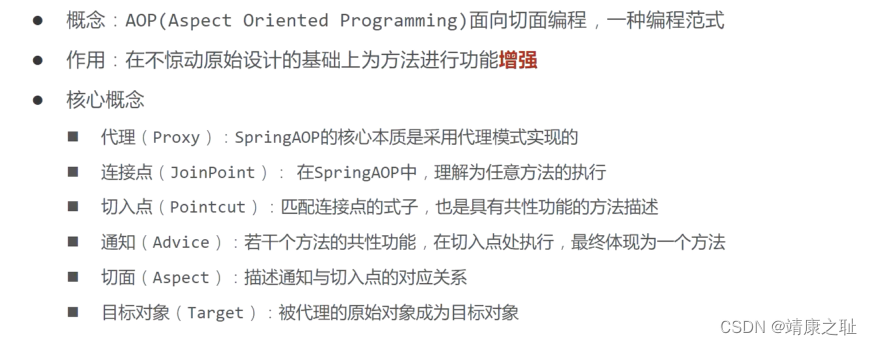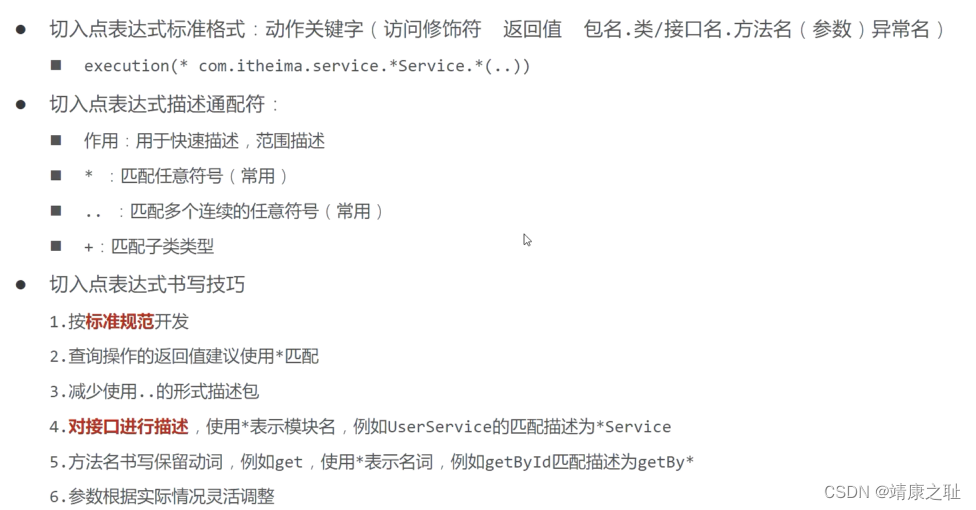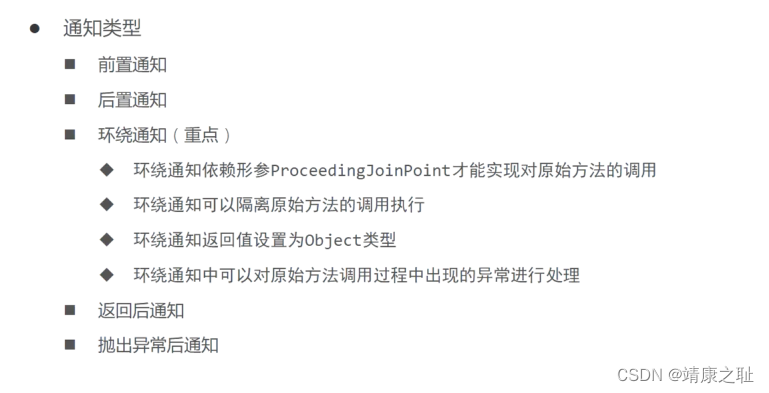Spring之AOP简单讲解
| 阿里云国内75折 回扣 微信号:monov8 |
| 阿里云国际,腾讯云国际,低至75折。AWS 93折 免费开户实名账号 代冲值 优惠多多 微信号:monov8 飞机:@monov6 |
目录
一基本概念
AOP Aspect Oriented Programming 面向切面编程,一种编程范式指导开发者如何组织程序结构 是对面向对象编程OOP的升华。OOP(Object Oriented Programming)是纵向对一个事物的抽象 一个对象包括静态的属性信息 包括动态的方法信息等。而AOP是横向的对不同事物的抽象 属性与属性、方法与方法、对象与对象都可以组成一个切面而用这种思维去设计编程的方式叫做面向切面编程
作用在不惊动原始设计的基础上为其进行功能增强
Spring理念无入侵式/无侵入式



二案例模拟AOP的基础代码
其实在之前学习BeanPostProcessor时 在BeanPostProcessor的after方法中使用动态代理对Bean进行了增强 实际存储到单例池singleObjects中的不是当前目标对象本身 而是当前目标对象的代理对象Proxy 这样在调用目标对象方法时 实际调用的是代理对象Proxy的同名方法 起到了目标方法前后都进行增强的功能对该方式进行一下优化将增强的方法提取出去到一个增强类中且只对com.tangyuan.service.impl包下的任何类的任何方法进行增强
//自定义增强类
public class My Advice{
public void beforeAdvice() {
System.out.println("beforeAdvice...")
}
public void afterAdvice() {
System.out.println("afterAdvice...")
}
}1.创建service类
public interface UserService {
void show1();
void show2();
} 2.实现service的实现类
public class UserServiceImpl implements UserService {
@Override
public void show1() {
System.out.println(show1.....);
}
@Override
public void show2() {
System.out.println(show2.....);
}
}ps:以上目标对象,目标类已经准备完成
3.创建增强类,内部提供增强方法
public class MyAdvice{
//前置增强方法
public void beforeAdvice(){
System.out.println(前置的增强.....);
}
public void afterAdvice(){
System.out.println(后置的增强.....);
}
}
目的在执行show1()方法的同时,也要将before和after的方法执行
4.将UserServiceImpl类和MyAdvic类配置到xml文件Spring容器中
<bean id="userService" class="com.tangyuan.service.impl.UserServiceImpl"></bean>
<bean id="myAdvice" class="com.tangyuan.advice.MyAdvice"></bean>5.BeanProxy对象创建
public class MockAopBeanPostProcessor implements BeanPostProcessor,ApplicationContextAware{
//成员变量
private ApplicationContext applicationContext;
@Override
public Object postProcessAfterInitialization(Object bean, String beanName) throws BeansException {
//目的对UserServiceImpl中的show1和show2方法进行增强,增强方法存在于MyAdvice类中
//问题1.筛选Service,impl包下的所有的类的所有方法都可以进行增强----解决方案if-else
//2.MyAdvice怎么获取到?解决方案:从Spring容器中获得MyAdvice
if(bean.getClass().getPackage().getName().equals("com.tangyuan.service.impl")){
//生成当前bean的Proxy对象
Object beanProxy=Proxy.newProxyInstance(
bean.getClass().getClassLoader(),
bean.getClass().getInterfaces(),
(Object proxy,Method method,Object[] args) -> {
MyAdvice myAdvice=applicationContext.getBean(MyAdvice.class);
//执行增强对象的before方法
myAdvice.beforeAdvice();
//执行目标对象的目标方法
Object result = method.invoke(bean, args);
//执行增强对象的after法
myAdvice.afterAdvice();
return result;
}
);
return beanProxy;
}
return bean;
}
@Override
public void setApplicationContext(ApplicationContext applicationContext) throws BeansException {
this.applicationContext=applicationContext;
}
}
6.将 MockAopBeanPostProcessor类配置到xml文件Spring容器中
7.测试
ClassPathXmlApplicationContext applicationContext=new ClassPathXmlApplicationContext("applicationContext.xml");
IUserService userService = applicationContext.getBean(UserService.class);
userService.show1();三AOP相关概念
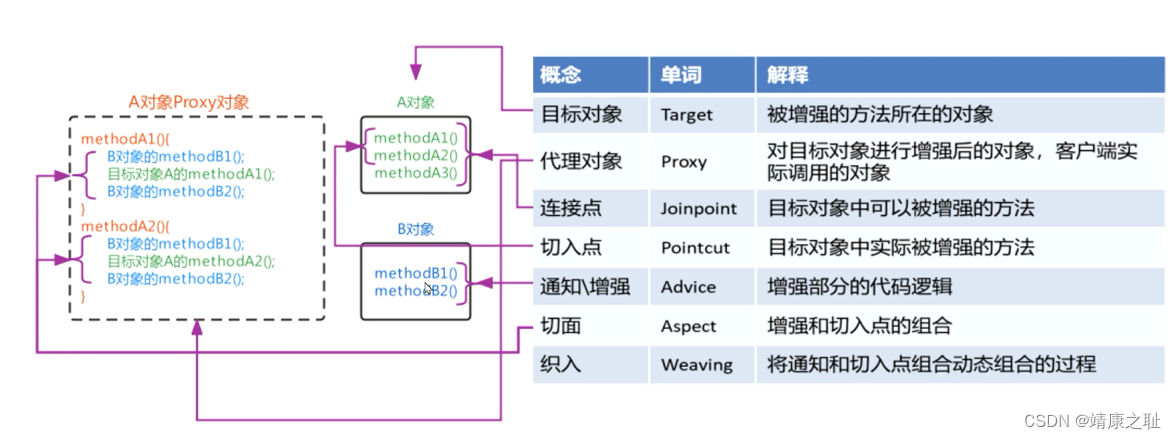
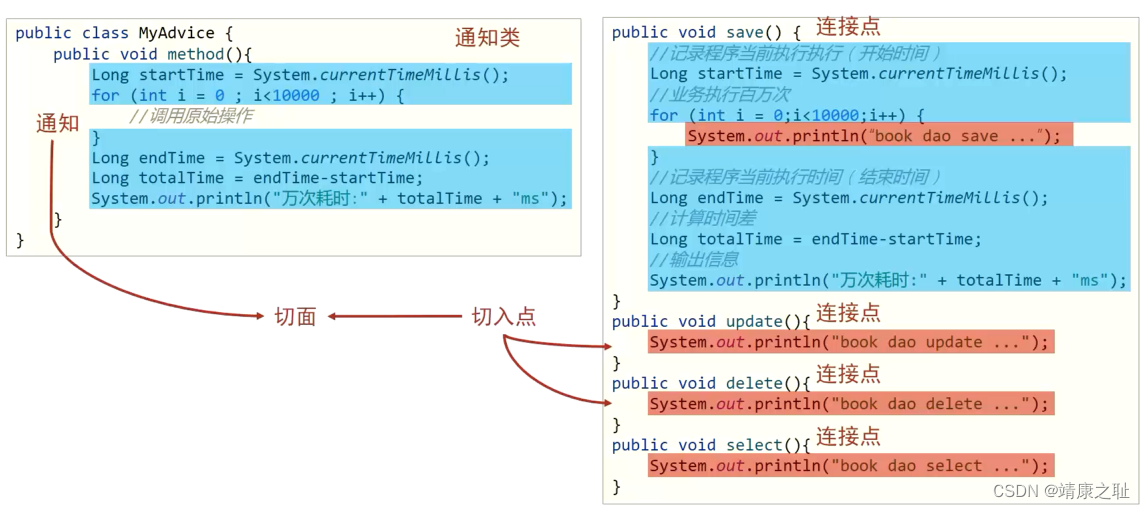

切入点范围小连接点范围大切入点一定在连接点中
四AOP入门案例思路分析
目的在接口执行前输出当前系统时间
开发模式xml or 注解
思路分析
1.导入坐标(pom.xml)
<dependencies>
<dependency>
<groupId>org.springframework</groupId>
<artifactId>spring-context</artifactId>
<version>5.2.10.RELEASE</version>
</dependency>
<dependency>
<groupId>org.aspectj</groupId>
<artifactId>aspectjweaver</artifactId>
<version>1.9.4</version>
</dependency>
</dependencies>spring-context坐标依赖spring-aop坐标

2.制作连接点方法(原始操作Dao接口与实现类)
public interface BookDao {
public void save();
public void update();
}import com.tangyuan.dao.BookDao;
import org.springframework.beans.factory.annotation.Value;
import org.springframework.stereotype.Repository;
@Repository
public class BookDaoImpl implements BookDao {
public void save() {
System.out.println(System.currentTimeMillis());
System.out.println("book dao save ...");
}
public void update(){
System.out.println("book dao update ...");
}3.制作共性功能(通知类与通知)
创建一个类用来存储共性功能
import org.aspectj.lang.annotation.Aspect;
import org.aspectj.lang.annotation.Before;
import org.aspectj.lang.annotation.Pointcut;
import org.springframework.stereotype.Component;
//通知类必须配置成Spring管理的bean
@Component
//设置当前类为切面类类
@Aspect
public class MyAdvice {
//4.定义切入点
//设置切入点要求配置在方法上方
@Pointcut("execution(void com.tangyuan.dao.BookDao.update())")
private void pt(){}
//5.绑定切入点与通知关系(切面)
//设置在切入点pt()的前面运行当前操作前置通知
@Before("pt()")
public void method(){
System.out.println(System.currentTimeMillis());
}
}4.定义切入点
切入点定义依托一个不具有实际意义的方法进行即无参数无返回值方法体无实际逻辑
5.绑定切入点与通知关系(切面)并指定通知添加到原始接点的具体执行位置
6.定义通知类受Spring容器管理并定义当前类为切面类
7.在配置类中进行相关属性的配置开启Spring对AOP注解驱动支持
五AOP工作流程
1.Spring容器启动
2.读取所有切面配置中的切入点
@Component
@Aspect
public class MyAdvice{
@Pointcut("execution(void com.tangyuan.dao.BookDao.save())")
private void ptx() {}
@Pointcut("execution(void com.tangyuan.dao.BookDao.update())")
private void pt() {}
@Before("pt() ")
public void method() {
System.out.println(System.currentTimeMiLLis() )
}
}
3.初始化bean判定bean对应的类中的方法是否匹配到任意切入点
匹配失败创建对象
匹配成功创建原始对象(目标对象)的代理对象
4.获取bean执行方法
获取bean调用方法并执行完成操作
获取的bean是代理对象时根据代理对象的运行模式运行原始方法与增强的内容完成操作
六AOP核心概念
目标对象(Target) 原始功能去掉共性功能对应的类产生的对象 这种对象是无法直接完成最终工作的
代理(Proxy) 目标对象无法直接完成工作 需要对其进行功能回填 通过原始对象的代理对象实现
七AOP切入点表达式
切入点要进行增强的方法
切入点表达式要进行增强的方法的描述方式
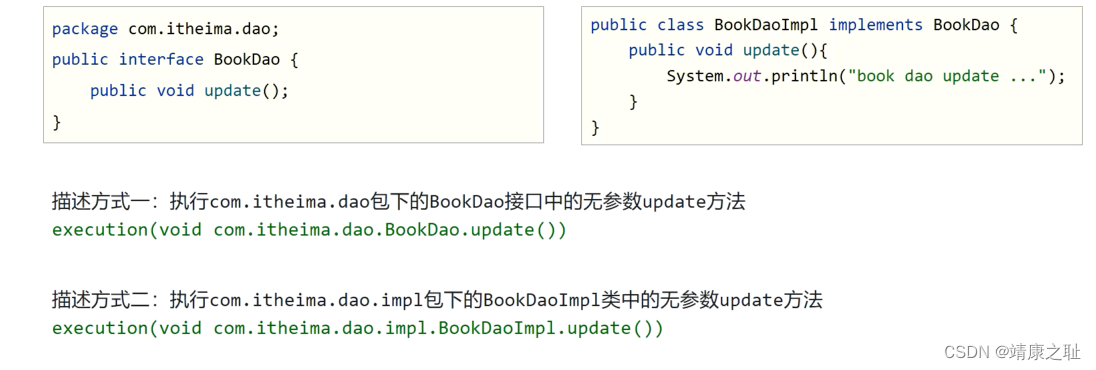



八xml方式AOP快速入门
前面我们自己编写的AOP基础代码还是存在一些问题的 主要如下
-
被增强的包名在代码写死了
-
通知对象的方法在代码中写死了
if("com.tangyuan.service.impl".equals(packageName) ) {
//对Bean进行动态代理 返回的是Proxy代理对象
Object proxy Bean=Proxy.new Proxy Instance(
bean.getClass() .getClassLoader()
bean.getClass() .get Interfaces()
(Object proxyMethod method Object[] args)->{
myAdvice.beforeAdvice() //执行Advice的before方法
Object result=method.invoke(bean args) //执行目标
myAdvice.afterAdvice() //执行Advice的after方法
return result
})
//返回代理对象
return proxyBean
}
return bean
}通过配置文件的方式去解决上述问题
-
配置哪些包、哪些类、哪些方法需要被增强
-
配置目标方法要被哪些通知方法所增强在目标方法执行之前还是之后执行增强
配置方式的设计、配置文件(注解) 的解析工作 Spring已经帮我们封装好了
xml方式配置AOP的步骤
1、导入AOP相关坐标
2、准备目标类、准备增强类 并配置给Spring管理
3、配置切点表达式(哪些方法被增强)
4、配置织入(切点被哪些通知方法增强是前置增强还是后置增强)。
1.导入AOP相关坐标
<dependency>
<groupId>org.aspectj</groupId>
<artifactId>aspectjweaver</artifactId>
<version>1.9.6</version>
</dependency>2.目标和通知
<!--配置目标类-->
<bean id="userService" class="com.tangyuan.service.impl.UserServiceImpl"></bean>
<!--配置通知类-->
<bean id="myAdvice" class="com.tangyuan.advice.MyAdvice"></bean>3.配置aop的命名空间
xmlns:aop="http://www.springframework.org/schema/aop"
http://www.springframework.org/schema/aop
http://www.springframework.org/schema/aop/spring-aop.xsd4.配置切点表达式
<!--aop配置-->
<aop:config>
<!--配置切点表达式目的是要指定哪些方法被增强-->
<aoppointcut id="myPointcut" expression="execution(void com.tangyuan.service.impl.UserServiceImpl.show1() ) "/>
<!--配置织入目的是要执行哪些切点与那些通知进行结合-->
<aopaspect ref="myAdvice">
<aopbefore method="beforeAdvice" pointcut-ref="myPointcut"/>
</aopaspect>
</aop:config>
xml配置AOP的方式还是比较简单的 下面看一下AOP详细配置的细节
-
切点表达式的配置方式
-
切点表达式的配置语法
-
通知的类型
-
AOP的配置的两种方式
ps:
1.切点表达式可以配置在外部,可以使用pointcut-ref来引用切点表达式的id
2.pointcut="execution(void com.tangyuan.service.impl.UserServiceImpl.show1() )"
3.切点表达式可以配置多个
切点表达式是配置要对哪些连接点(哪些类的哪些方法)进行通知的增强语法如下
execution([访问修饰符] 返回值类型包名.类名.方法名(参数) )其中
-
访问修饰符可以省略不写
-
返回值类型、某一级包名、类名、方法名可以使用*表示任意
-
包名与类名之间使用单点.表示该包下的类使用双点..表示该包及其子包下的类
-
参数列表可以使用两个点..表示任意参数。
切点表达式举几个例子方便理解
//表示访问修饰符为public、无返回值、在com.tangyuan.aop包下的TargetImpl类的无参方法show
execution(public void com.tangyuan.aop.TargetImpl.show() )
//表述com.tangyuan.aop包下的Target Impl类的任意方法
execution(*com.tangyuan.aop.Target Impl.*(..) )
//表示com.tangyuan.aop包下的任意类的任意方法
execution(*com.tangyuan.aop.*.*(..) )
//表示com.tangyuan.aop包及其子包下的任意类的任意方法
execution(*com.tangyuan.aop..*.*(..) )
//表示任意包中的任意类的任意方法
execution(**..*.*(..) )AOP通知描述了抽取的共性功能根据共性功能抽取的位置不同最终运行代码时要将其加入到合理的位置

public void beforeAdvice() {
System.out.println("前置的增强....")
}
public void after Returning Advice() {
System.out.println("后置的增强....")
}
<--环绕通知方法-->
public Object around(ProceedingJoinPoint proceedingJoinPoint)throws Throwable{
System.out.println("环绕前的增强....")
Object res=proceedingJoinPoint.proceed() //执行目标方法
System.out.println("环绕后的增强....")
return res
}
public void afterThrowingAdvice() {
System.out.println("异常抛出通知...报异常才执行")
}
public void afterAdvice() {
System.out.println("最终的增强....")
}
<!--前置通知-->
<aopbefore method="beforeAdvice" pointout-ref="myPointcut2"/>
<!--后置通知-->
<aopafter-returning method="afterReturningAdvice" pointcut-ref-"myPointcut2”
<!--坏绕通知-->
<aoparound method="around" pointcut-ref="myPointcut2"/>
<!--异常抛出通知-->
<aopafter-throwing method="afterThrowingAdvice" pointcut-ref="myPointcut2"/>
<!--最终通知-->
<aopafter method="afterAdvice" pointcut-ref="myPointcut2"/> 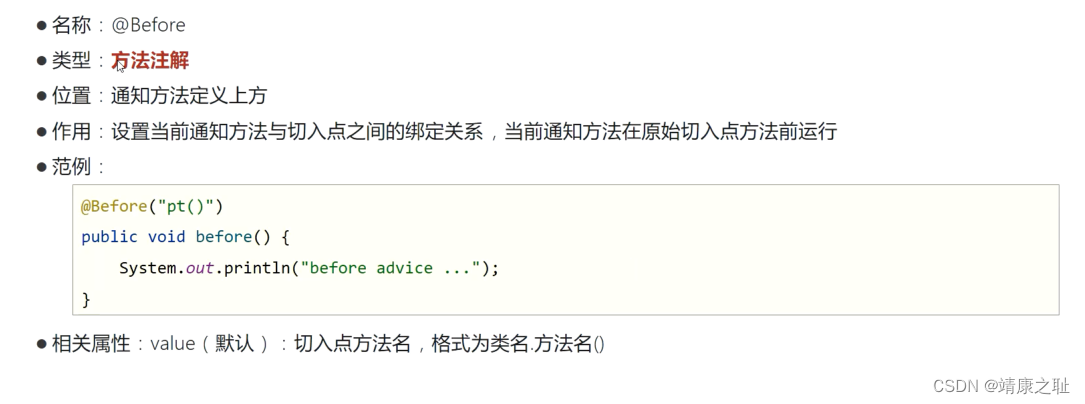

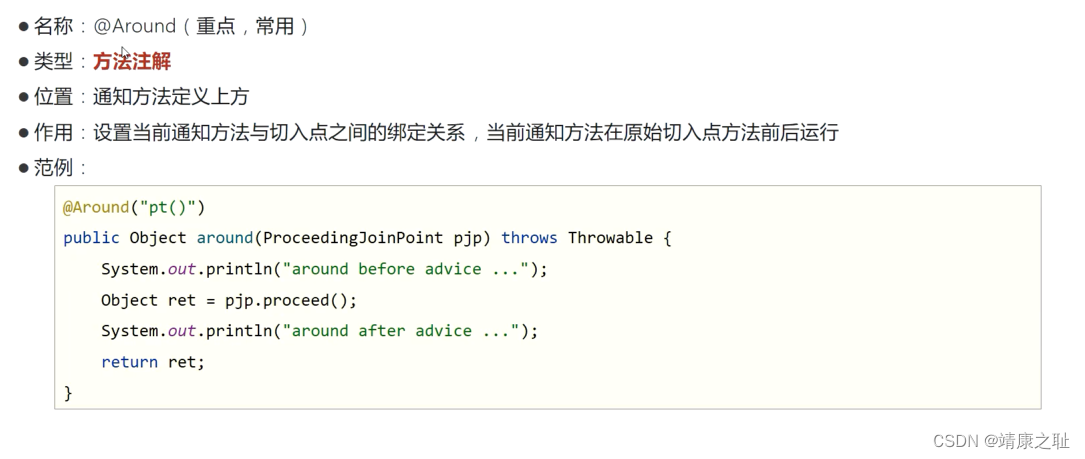
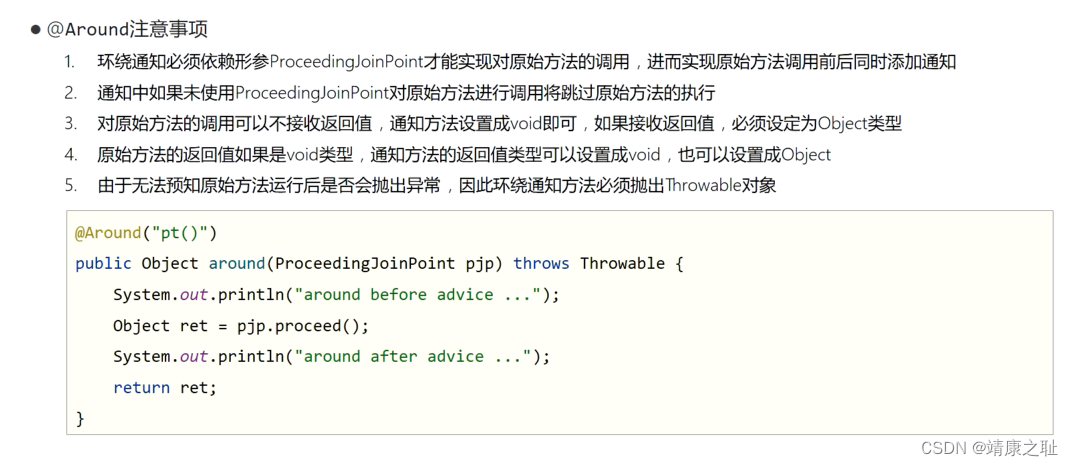
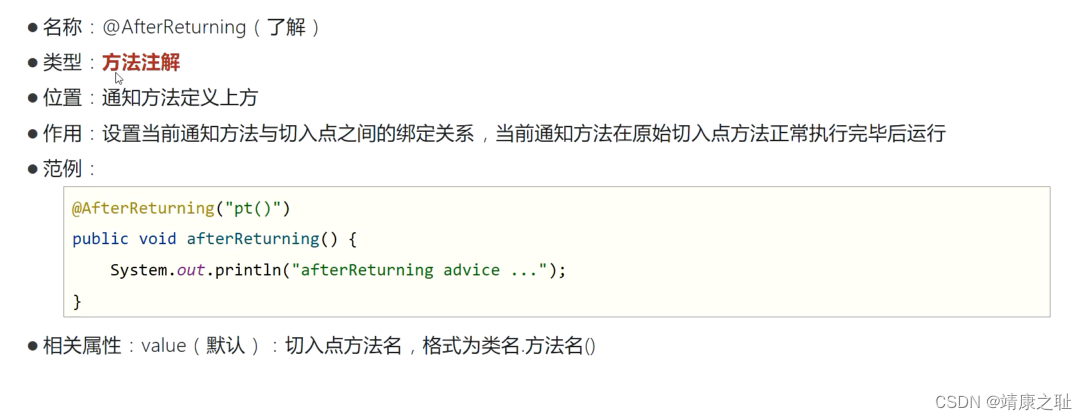
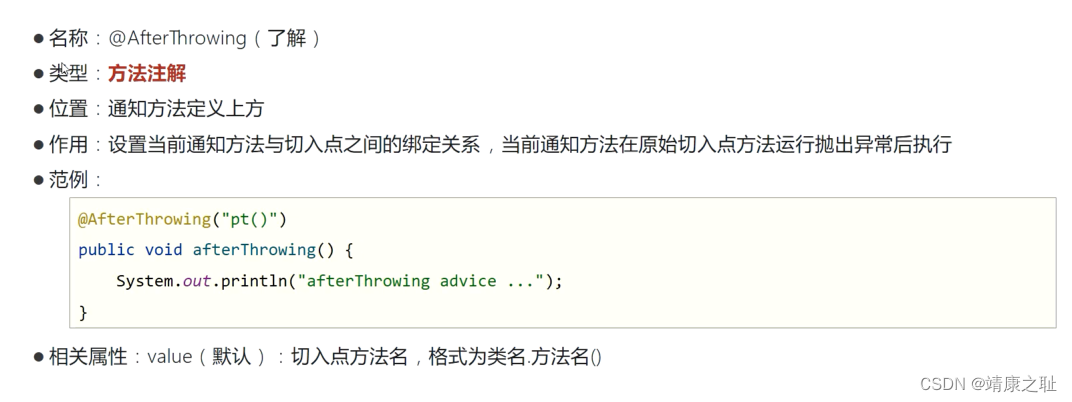
九案例测量业务层接口万次执行效率

1.dao接口
import com.tangyuan.domain.Account;
import org.apache.ibatis.annotations.Delete;
import org.apache.ibatis.annotations.Insert;
import org.apache.ibatis.annotations.Select;
import org.apache.ibatis.annotations.Update;
import java.util.List;
public interface AccountDao {
@Insert("insert into tbl_account(name,money)values(#{name},#{money})")
void save(Account account);
@Delete("delete from tbl_account where id = #{id} ")
void delete(Integer id);
@Update("update tbl_account set name = #{name} , money = #{money} where id = #{id} ")
void update(Account account);
@Select("select * from tbl_account")
List<Account> findAll();
@Select("select * from tbl_account where id = #{id} ")
Account findById(Integer id);
}2.service接口及实现类
import com.tangyuan.domain.Account;
import java.util.List;
public interface AccountService {
void save(Account account);
void delete(Integer id);
void update(Account account);
List<Account> findAll();
Account findById(Integer id);
}import com.tangyuan.dao.AccountDao;
import com.tangyuan.domain.Account;
import com.tangyuan.service.AccountService;
import org.springframework.beans.factory.annotation.Autowired;
import org.springframework.stereotype.Service;
import java.util.List;
@Service
public class AccountServiceImpl implements AccountService {
@Autowired
private AccountDao accountDao;
public void save(Account account) {
accountDao.save(account);
}
public void update(Account account){
accountDao.update(account);
}
public void delete(Integer id) {
accountDao.delete(id);
}
public Account findById(Integer id) {
return accountDao.findById(id);
}
public List<Account> findAll() {
return accountDao.findAll();
}
}3.实体类
import java.io.Serializable;
public class Account implements Serializable {
private Integer id;
private String name;
private Double money;
public Integer getId() {
return id;
}
public void setId(Integer id) {
this.id = id;
}
public String getName() {
return name;
}
public void setName(String name) {
this.name = name;
}
public Double getMoney() {
return money;
}
public void setMoney(Double money) {
this.money = money;
}
@Override
public String toString() {
return "Account{" +
"id=" + id +
", name='" + name + '\'' +
", money=" + money +
'}';
}
}4.配置类
import com.alibaba.druid.pool.DruidDataSource;
import org.springframework.beans.factory.annotation.Value;
import org.springframework.context.annotation.Bean;
import org.springframework.context.annotation.Configuration;
import javax.sql.DataSource;
public class JdbcConfig {
@Value("${jdbc.driver}")
private String driver;
@Value("${jdbc.url}")
private String url;
@Value("${jdbc.username}")
private String userName;
@Value("${jdbc.password}")
private String password;
@Bean
public DataSource dataSource(){
DruidDataSource ds = new DruidDataSource();
ds.setDriverClassName(driver);
ds.setUrl(url);
ds.setUsername(userName);
ds.setPassword(password);
return ds;
}
}import org.mybatis.spring.SqlSessionFactoryBean;
import org.mybatis.spring.mapper.MapperScannerConfigurer;
import org.springframework.context.annotation.Bean;
import javax.sql.DataSource;
public class MybatisConfig {
@Bean
public SqlSessionFactoryBean sqlSessionFactory(DataSource dataSource){
SqlSessionFactoryBean ssfb = new SqlSessionFactoryBean();
ssfb.setTypeAliasesPackage("com.itheima.domain");
ssfb.setDataSource(dataSource);
return ssfb;
}
@Bean
public MapperScannerConfigurer mapperScannerConfigurer(){
MapperScannerConfigurer msc = new MapperScannerConfigurer();
msc.setBasePackage("com.itheima.dao");
return msc;
}
}import org.springframework.context.annotation.*;
@Configuration@ComponentScan("com.itheima")
@PropertySource("classpath:jdbc.properties")
@Import({JdbcConfig.class,MybatisConfig.class})
@EnableAspectJAutoProxy
public class SpringConfig {}5.切面类
import org.aspectj.lang.ProceedingJoinPoint;
import org.aspectj.lang.Signature;
import org.aspectj.lang.annotation.Around;
import org.aspectj.lang.annotation.Aspect;
import org.aspectj.lang.annotation.Pointcut;
import org.springframework.stereotype.Component;
@Component
@Aspect
public class ProjectAdvice {
//匹配业务层的所有方法
@Pointcut("execution(* com.itheima.service.*Service.*(..))")
private void servicePt(){}
//设置环绕通知在原始操作的运行前后记录执行时间
@Around("ProjectAdvice.servicePt()")
public void runSpeed(ProceedingJoinPoint pjp) throws Throwable {
//获取执行的签名对象
Signature signature = pjp.getSignature();
//通过签名获取执行类型(接口名)
String className = signature.getDeclaringTypeName();//com.tangyuan.service.AccountService
//通过签名获取执行操作名称(方法名)
String methodName = signature.getName();//findById
long start = System.currentTimeMillis();
for (int i = 0; i < 10000; i++) {
pjp.proceed();
}
long end = System.currentTimeMillis();
System.out.println("万次执行"+ className+"."+methodName+"---->" +(end-start) + "ms");
}
当前测试的接口效率仅仅是一个理论值并不是一次完整的执行过程
通知方法在被调用时 Spring可以为其传递一些必要的参数
| 参数类型 | 作用 |
|---|---|
| JoinPoint | 连接点对象任何通知都可使用可以获得当前目标对象、目标方法参数等信息 |
| ProceedingJoinPoint | JoinPoint子类对象 主要是在环绕通知中执行proceed() 进而执行目标方法 |
| Throwable | 异常对象使用在异常通知中需要在配置文件中指出异常对象名称 |
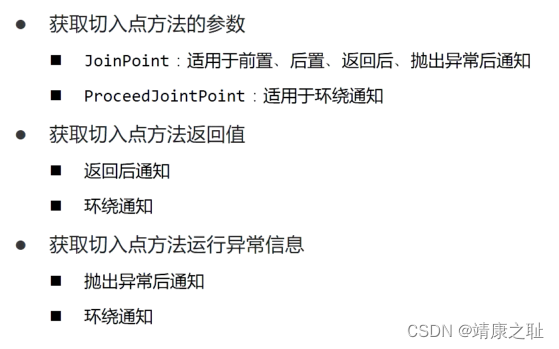
JoinPoint对象
描述了连接点方法的运行状态可以获取到原始方法的调用参数
public void 通知方法名称(JoinPoint joinPoint) {
//获得目标方法的参数
System.out.println(joinPoint.getArgs() )
//获得目标对象
System.out.println(joinPoint.getTarget() )
//获得精确的切点表达式信息
System.out.println(joinPoint.getStaticPart() )
}ProceedingJoinPoint对象是JoinPoint的子类
public Object around(ProceedingJoinPoint joinPoint) throws Throwable{ System.out.println(joinPoint.getArgs() ) //获得目标方法的参数 System.out.println(joinPoint.getTarget() ) //获得目标对象 System.out.println(joinPoint.getStaticPart() ) //获得精确的切点表达 Objectresult=joinPoint.proceed() //执行目标方法 return result //返回目标方法返回值}Throwable对象
public void afterThrowing(JoinPoint joinPoint Throwable th) {
//获得异常信息
System.out.println("异常对象是"+th+"异常信息是"+th.get Message() )
}<aopafter-throwing method="afterThrowing" pointcut-ref="myPointcut" throwing="th"/>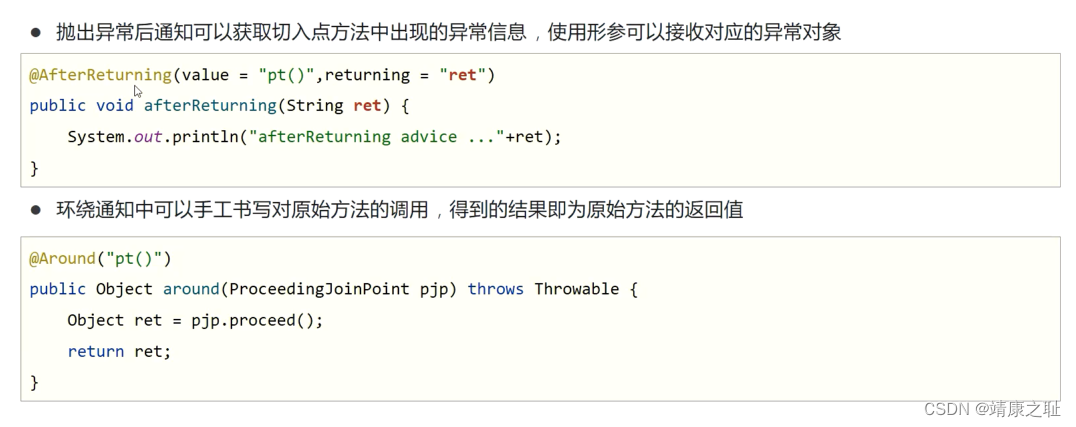
十案例百度网盘密码数据兼容处理

1.dao接口及实现类
public interface ResourcesDao {
boolean readResources(String url, String password);
}@Repository
public class ResourcesDaoImpl implements ResourcesDao {
public boolean readResources(String url, String password) {
System.out.println(password.length());
//模拟校验
return password.equals("root");
}
}2.service接口及实现类
public interface ResourcesService {
public boolean openURL(String url ,String password);
}import com.tangyuan.dao.ResourcesDao;
import com.tangyaun.service.ResourcesService;
import org.springframework.beans.factory.annotation.Autowired;
import org.springframework.stereotype.Service;
@Service
public class ResourcesServiceImpl implements ResourcesService {
@Autowired
private ResourcesDao resourcesDao;
public boolean openURL(String url, String password) {
return resourcesDao.readResources(url,password);
}
}3.配置类
import org.springframework.context.annotation.ComponentScan;
import org.springframework.context.annotation.Configuration;
import org.springframework.context.annotation.EnableAspectJAutoProxy;
@Configuration
@ComponentScan("com.tangyuan")
@EnableAspectJAutoProxy
public class SpringConfig {
}4.切面类
import org.aspectj.lang.ProceedingJoinPoint;
import org.aspectj.lang.annotation.Around;
import org.aspectj.lang.annotation.Aspect;
import org.aspectj.lang.annotation.Pointcut;
import org.springframework.stereotype.Component;
@Component
@Aspect
public class DataAdvice {
@Pointcut("execution(boolean com.tangyuan.service.*Service.*(*,*))")
private void servicePt(){}
@Around("DataAdvice.servicePt()")
public Object trimStr(ProceedingJoinPoint pjp) throws Throwable {
//获取参数
Object[] args = pjp.getArgs();
//遍历参数
for (int i = 0; i < args.length; i++) {
//判断参数是不是字符串
if(args[i].getClass().equals(String.class)){
args[i] = args[i].toString().trim();
}
}
Object ret = pjp.proceed(args);
return ret;
}
}5.测试
import com.tangyuan.config.SpringConfig;
import com.tangyuan.service.ResourcesService;
import org.springframework.context.ApplicationContext;
import org.springframework.context.annotation.AnnotationConfigApplicationContext;
public class App {
public static void main(String[] args) {
ApplicationContext ctx = new AnnotationConfigApplicationContext(SpringConfig.class);
ResourcesService resourcesService = ctx.getBean(ResourcesService.class);
boolean flag = resourcesService.openURL("http://pan.baidu.com/haha", "root ");
System.out.println(flag);
}
}AOP配置的两种语法形式
AOP的xml有两种配置方式 如下
-
使用<advisor>配置切面
-
使用<aspect>配置切面
Spring定义了一个Advice接口 实现了该接口的类都可以作为通知类出现
public interface Advice{ }advisor需要的通知类需要实现Advice的子功能接口 例如MethodBeforeAdvice、AfterReturningAdvice等 是通过实现的接口去确定具备哪些通知增强的 见代码演示
<!--通知规范类-->
public class MyAdvice2 implements MethodBeforeAdvice AfterReturningAdvice{
@Override
public void before(Method method Object[] objects Object o) throws Throwable {
System.out.println("前置通知.."}
}
@Override
public void afterReturning(Object o Method method Object[] objects Object o) throws Throwable
System.out.println("后置通知...........")
}
}public class MyAdvice3 implements MethodInterceptor{
@Override
public Object invoke(MethodInvocation methodInvocation) throws Throwable{
System.out.println("环绕前...........")
//执行目标方法
Object res=method Invocation.getMethod() .invoke(methodInvocation.getThis()methodInvocation.getArguments() )
System.out.println("环绕后...........")
return res
}AOP配置的两种语法形式不同点
语法形式不同
-
advisor是通过实现接口来确认通知的类型,如MyAdvice2
-
aspect是通过配置确认通知的类型 更加灵活,如
-
<aop:aspect ref="myadvice"> <aop:after method="afterAdvice" pointcut-ref="myPointcut2"/> /aop:aspect
可配置的切面数量不同
-
一个advisor只能配置一个固定通知和一个切点表达式
-
一个aspect可以配置多个通知和多个切点表达式任意组合
使用场景不同
-
允许随意搭配情况下可以使用aspect进行配置
-
如果通知类型单一、切面单一的情况下可以使用advisor进行配置
-
在通知类型已经固定 不用人为指定通知类型时 可以使用advisor进行配置 例如后面要学习的Spring事务控制的配置
-
xml方式AOP原理剖析

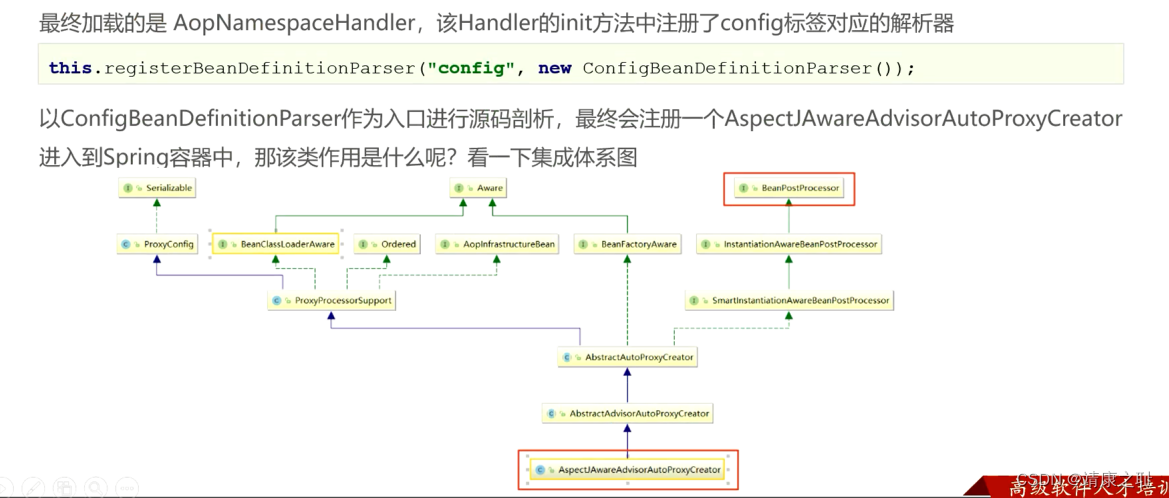

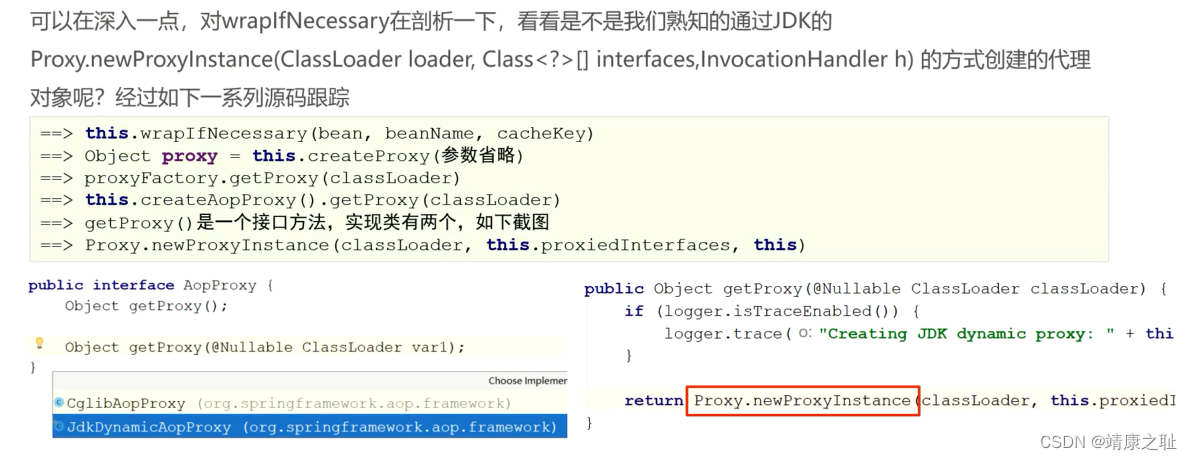


JDK的动态代理代码 之前已经写过了 下面看一下Cglib基于超类的动态代理
Target target=new Target() //目标对象
Advices advices三new Advices() //通知对象
Enhancer enhancer=new Enhancer() //增强器对象
enhancer.setSuperclass(Target.class) //增强器设置父类
//增强器设置回调
enhancer.set Callback( (MethodInterceptor) (o methodobjectsmethod Proxy)一>{
advices.before()
Object result=method.invoke(target objects)
advices.afterReturning()
return result
})
//创建代理对象
Target targetProxy=(Target) enhancer.create()
//测试
String result=targetProxy.show("haohao") -
注解方式AOP基本使用
Spring的AOP也提供了注解方式配置 使用相应的注解替代之前的xml配置 xml配置AOP时 我们主要配置了三 部分目标类被Spring容器管理、通知类被Spring管理、通知与切点的织入(切面) 如下
<!--配置目标-->
<bean id="target"class="com.tangyuan.aop.Target Impl"></bean>
<!--配置通知-->
<bean id="advices"class="com.tangyuan.aop.Advices"></bean>
<!--配置aop-->
<aopconfig proxy-target-class="true">
<aopaspect ref="advices">
<aoparound method="around"pointcut="execution(*com.tangyuan.aop.*.*(..))"/>
</aopaspect>
</aopconfig>1.接口service类
@Service("userService")
public class UserServiceImpl implements UserService{ }2.增强类
//增强类内部提供增强方法
@Component
@Aspect
public class MyAdvice{
//<aopbeforemethod="beforeAdvice"pointcut="execution(*com.tangyuan.service.impl.*.*(..))"/>
@Before("execution(*com.tangyuan.service.impl.*.*(..) ) ")
public void beforeAdvice(JoinPoint joinPoint) {
System.out.println("当前目标对象是"+joinPoint.getTarget() )
System.out.println("表达式"+joinPoint.getStaticPart() )
System.out.println("前置的增强....")
}
}3.在xml文件中进行配置
<!--组件扫描-->
<contextcomponent-scan base-package="com.tangyuan"/>
<!--使用注解配置AOP 需要开启AOP自动代理-->
<aopaspectj-autoproxy/>
各种注解方式通知类型
//前置通知
@Before("execution(*com.tangyuan.aop.*.*(..) ) ")
public void before(JoinPoint joinPoint) {}
//后置通知
@AfterReturning("execution(*com.tangyuan.aop.*.*(..) ) ")
public void AfterReturning(JoinPoint joinPoint) {}
//环绕通知
@Around("execution(*com.tangyuan.aop.*.*(..) ) ")
public void around(ProceedingJoinPoint joinPoint) throws Throwable{}
//异常通知
@AfterThrowing("execution(*com.tangyuan.aop.*.*(..) ) ")
public void AfterThrowing(Join Point join Point) {}
//最终通知
@After("execution(*com.tangyuan.aop.*.*(..) ) ")
public void After(JoinPoint joinPoint) {}
//切点表达式的抽取
@Pointcut("execution(*com.tangyuan.service.impl.*.*(..))")
public void myPointcut() {}
使用
@Around(“类名.myPointcut()”@Confiquration
@ComponentScan("com.tangyuan")//<contextcomponent-scan base-package="com.tangyuan"/>
@EnableAspectJAutoProxy //<aopaspectj-autoproxy/>
public class Spring Config{ }
-
注解方式AOP原理剖析



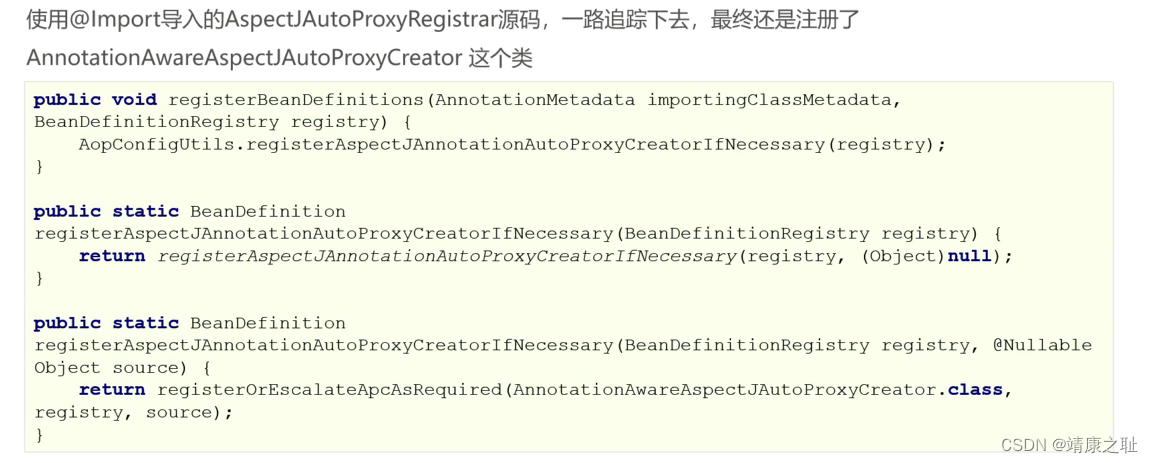
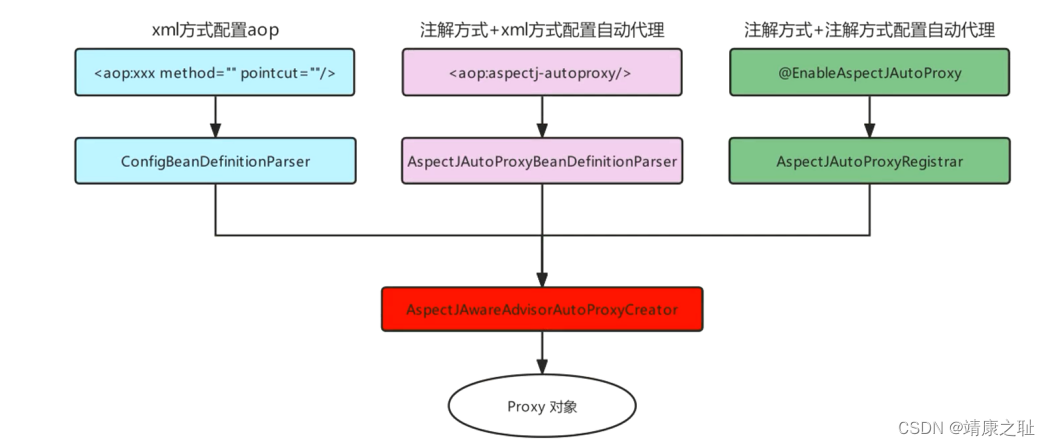
十一AOP总结
